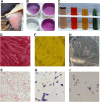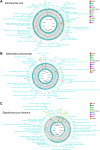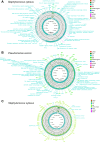The metagenomic and whole-genome metagenomic detection of multidrug-resistant bacteria from subclinical mastitis-affected cow's milk in India
- PMID: 40330015
- PMCID: PMC12053146
- DOI: 10.3389/fcimb.2025.1549523
The metagenomic and whole-genome metagenomic detection of multidrug-resistant bacteria from subclinical mastitis-affected cow's milk in India
Abstract
Multidrug-resistant (MDR) bacteria in farm animal products threaten human health by causing zoonotic infections. The complete genome sequences of MDR bacteria from subclinical mastitis-affected cow's milk have not yet been comprehensively documented in India. In this study, using a bacterial metagenomic sequencing approach, we detected the nearly complete genome sequences of Pseudomonas veronii and Staphylococcus xylosus from subclinical mastitis-affected cow's milk. Furthermore, we sequenced the nearly complete genome sequences of Escherichia coli, Klebsiella pneumoniae, Staphylococcus hominis, and S. xylosus from subclinical mastitis-affected cow's milk using a whole-genome metagenomic sequencing method. Our analysis subsequently revealed that the complete genome sequences of the identified bacteria contained MDR genes and genes for multiple virulence factors. These MDR bacteria may pose a public health risk through exposure to milkers, milk handlers, and farm workers or through the handling and consumption of unpasteurized milk.
Keywords: E. coli; ESKAPE pathogens; mastitis-affected cow’s milk; multidrug-resistant bacteria; pathogenic bacteria.
Copyright © 2025 Manimaran, Desingu, Kumaresan, Singh, Subramanya, Dodamani and Dineshbhai.
Conflict of interest statement
The authors declare that the research was conducted in the absence of any commercial or financial relationships that could be construed as a potential conflict of interest.
Figures




References
-
- Alcock B. P., Huynh W., Chalil R., Smith K. W., Raphenya A. R., Wlodarski M. A., et al. . (2023). CARD 2023: expanded curation, support for machine learning, and resistome prediction at the Comprehensive Antibiotic Resistance Database. Nucleic Acids Res. 51, D690–D699. doi: 10.1093/nar/gkac920 - DOI - PMC - PubMed
-
- Anika T. T., Noman Z. A., Islam M. S., Sultana N., Ashraf M. N., Pervin M., et al. . (2023). Draft genome sequence of multidrug-resistant Escherichia coli MAHK_SCM_BAU_30A strain isolated from a subclinical mastitis cow in Bangladesh. Microbiol. Resour. Announc. 12, e0071323. doi: 10.1128/MRA.00713-23 - DOI - PMC - PubMed
MeSH terms
Substances
LinkOut - more resources
Full Text Sources

